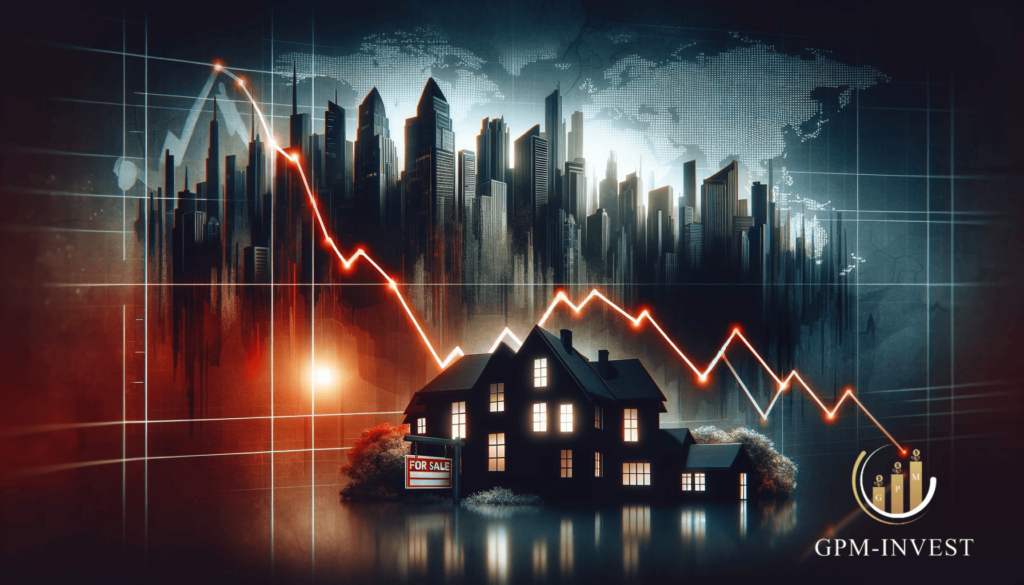Housing Market Freefall – America’s Real Estate Crisis Sparks Global Economic Alarm
By the Digital Zeitgeist, Geopolitical and Financial Analyst based in the UK
In the labyrinth of global economic indicators, the US housing market has often served as a reliable harbinger of broader financial health. The latest figures present a stark warning: US existing home sales have plummeted to their lowest in over a decade. This precipitous drop, a 4.1% slump in October, is the nadir of a market beset by skyrocketing mortgage rates and a housing shortfall. It is a scenario that casts a long shadow over the global economic landscape, with potential repercussions far beyond the borders of the United States.
A Domestic Downturn with International Implications
The National Association of Realtors (NAR) disclosed a seasonally adjusted annual rate of 3.79 million units, a trough unseen since the August of 2010. The significance of this cannot be overstated. As sales dwindled in the populous regions of the Northeast, West, and South, the Midwest remained stagnant, painting a picture of widespread economic malaise.
Economists had already adjusted their forecasts, bracing for a drop to a rate of 3.9 million units. The reality, however, surpassed even these pessimistic projections. This is not merely a domestic issue; the US housing market is often a precursor to global economic trends. As such, the international financial community watches these figures with a mix of trepidation and foresight.
The Catalysts of the Current Crisis
Lawrence Yun, NAR’s chief economist, attributes this downturn to the double jeopardy of scarce housing inventory and prohibitive mortgage rates—the highest in a generation. The average rate on a 30-year fixed-rate mortgage surged to levels last observed in late 2000, a staggering 7.31% in September, peaking at 7.79% in late October.
Though rates have since retreated, they remain high at an average of 7.44%. This escalation in borrowing costs has been nothing short of a stranglehold on potential home buyers, particularly as the labour market cools and inflation shows signs of subsiding.
Inventory and Affordability: A Constraining Couplet
The inventory of previously owned homes has contracted by 5.7% from last year, with a mere 1.15 million homes on the market in October. At the current sales velocity, existing housing stock would deplete in 3.6 months—a stark contrast to the 3.3 months a year ago. This shortage sustains a sellers’ market, with the median house price escalating by 3.4% from last year to $391,800—October’s highest on record.
The Global Domino Effect
The US housing market, often a microcosm of the larger economy, has broader implications for the world. The housing sector is integrally linked to job creation, consumer spending, and financial stability. A downturn here can ripple out, affecting manufacturing, retail, and international trade.
For instance, a decline in the housing market can lead to a decrease in demand for construction materials, home furnishings, and appliances. This reduced demand can affect countries that export these goods to the US, leading to potential job losses and decreased economic activity in those nations.
Moreover, the financial sector is also at risk. Mortgage-backed securities are global investments, and a downturn can diminish the value of these assets, potentially impacting financial institutions worldwide.
A Path Forward: Navigating the Uncertain Waters
Amid this challenging backdrop, all-cash sales have risen, accounting for 29% of transactions, up from 26% a year ago. This indicates a pivot towards more secure financial transactions in an uncertain market. Distressed sales, including foreclosures, have remained static, signifying a market that, while strained, is not yet in the throes of a crisis reminiscent of 2008.
Conclusion: Monitoring the Pulse of the Global Economy
The US housing market’s current trajectory is a clarion call for vigilance and preparedness. The market’s health—or lack thereof—is a critical indicator of economic stability, both domestically and internationally. As policymakers, investors, and financial experts scrutinise these developments, the overarching narrative is one of caution.
The global economy is navigating through a period of significant uncertainty, and the US housing market slump is a potent reminder of the interconnected nature of our financial systems. Stakeholders would be well-advised to heed these signs and prepare for a range of scenarios, ensuring that the ripple effect of this downturn does not become a tidal wave that engulfs the global economic and financial systems.
Disclaimer: The views and opinions expressed in this article are those of the author and do not necessarily reflect the official policy or position of GPM-Invest or any other organisations mentioned. The information provided is based on contemporary sourced digital content and does not constitute financial or investment advice. Readers are encouraged to conduct further research and analysis before making any investment decisions.

